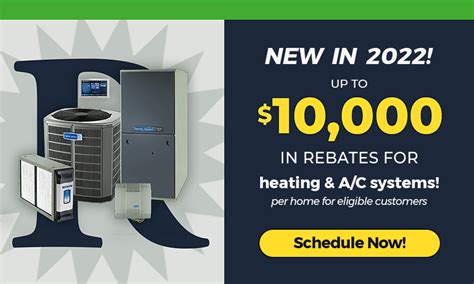Maximize Your Comfort and Savings: How to Take Advantage of HVAC Rebates
As energy costs continue to rise, homeowners are increasingly looking for ways to enhance their comfort while saving on utility bills. One effective way to achieve this is by upgrading your heating, ventilation, and air conditioning (HVAC) system. While the initial investment may seem daunting, numerous HVAC rebates are available that can significantly offset the cost of these upgrades. In this article, we will explore how you can take advantage of HVAC rebates to maximize your comfort and savings.
Understanding HVAC Rebates
HVAC rebates are financial incentives offered by various entities, including government agencies, utility companies, and manufacturers, to encourage homeowners to install energy-efficient HVAC systems. These rebates can help lower installation costs and promote environmentally friendly practices. It’s essential to understand the types of rebates available and how they can benefit you.
Types of HVAC Rebates
- Utility Company Rebates: Many utility companies provide rebates for customers who upgrade to energy-efficient HVAC systems. These rebates vary by region and depend on the specific energy-saving features of the system.
- Government Incentives: Federal, state, and local governments often offer tax credits and rebates to encourage energy-efficient upgrades. The Federal Investment Tax Credit (ITC) is a notable example that can provide substantial savings for eligible HVAC upgrades.
- Manufacturer Rebates: HVAC manufacturers frequently offer promotions or rebates on their energy-efficient models to encourage sales. Checking with your chosen brand can reveal additional savings opportunities.
How to Find HVAC Rebates
Finding HVAC rebates can seem overwhelming, but a structured approach can make the process more manageable. Here’s how to go about it:
- Research Local Utilities: Start by visiting your local utility company’s website. Many utilities have dedicated pages outlining available rebates and incentives for energy-efficient upgrades.
- Check Government Websites: Websites like the U.S. Department of Energy (DOE) and the Database of State Incentives for Renewables & Efficiency (DSIRE) can provide information on federal and state programs.
- Consult HVAC Contractors: Experienced HVAC contractors are often well-versed in available rebates and can help you understand the opportunities specific to your region.
Choosing the Right HVAC System for Rebates
To maximize your savings, it’s crucial to select an HVAC system that qualifies for the maximum amount of rebates. Here are some tips:
- Look for ENERGY STAR Certification: HVAC systems that meet or exceed ENERGY STAR® criteria are often eligible for rebates. Look for products that provide high efficiency and low energy consumption.
- Focus on SEER Ratings: The Seasonal Energy Efficiency Ratio (SEER) rating measures the cooling efficiency of air conditioners. A higher SEER rating generally qualifies for better rebates.
- Consider Smart Thermostats: Upgrading to a smart thermostat can not only improve comfort but may also make you eligible for additional rebates.
The Importance of Professional Installation
While it might be tempting to handle HVAC upgrades as a DIY project, professional installation is crucial to ensure optimal performance and rebate eligibility. Many rebate programs require that certified technicians install the systems. Additionally, professionals can help assess your home’s specific needs and recommend suitable products, further enhancing your savings and comfort.
Applying for HVAC Rebates
Once you’ve selected your HVAC system, the next step is applying for the applicable rebates. Here’s a simple guide to streamline the process:
- Gather Documentation: Keep all receipts, contract agreements, and product documentation handy. You may need these when applying for rebates.
- Complete Online Applications: Many rebate programs have online applications. Fill out these forms accurately to avoid delays.
- Follow Up: After submitting your application, be proactive and follow up with the respective rebate provider to confirm your application has been received and to inquire about the timeline for processing.
Conclusion
Upgrading your HVAC system is a crucial step toward improving your home’s comfort and energy efficiency. By taking advantage of available HVAC rebates, you can significantly reduce installation costs and enhance your savings. Whether you are considering utility company rebates, government incentives, or manufacturer promotions, the key is to do your research and choose the best options for your needs. With diligent planning and the right choices, you can maximize both your comfort and your savings.
FAQs
- 1. How much can I save through HVAC rebates?
- Rebate amounts can vary significantly based on the type of system, local programs, and availability of funds. Homeowners can expect to save anywhere from a few hundred to several thousand dollars.
- 2. Are HVAC rebates available for all types of systems?
- Not all HVAC systems qualify for rebates. Look for energy-efficient models that meet specific performance criteria, such as ENERGY STAR ratings.
- 3. What documentation do I need to apply for HVAC rebates?
- Typically, you will need receipts, the product model numbers, and possibly a copy of your installation contract. Always check the specific requirements of the rebate program.
- 4. How long does it take to receive my rebate?
- The processing time can vary based on the program. Generally, it can take anywhere from a few weeks to several months for rebates to be processed and issued.
- 5. Can I combine rebates from different sources?
- In many cases, you can combine rebates from utility companies, government programs, and manufacturer promotions, allowing for even greater savings.
This HTML document provides a thoroughly structured article including headers, paragraphs, lists, and a FAQ section, all formatted for a WordPress environment.
Download Rebates For New Hvac
